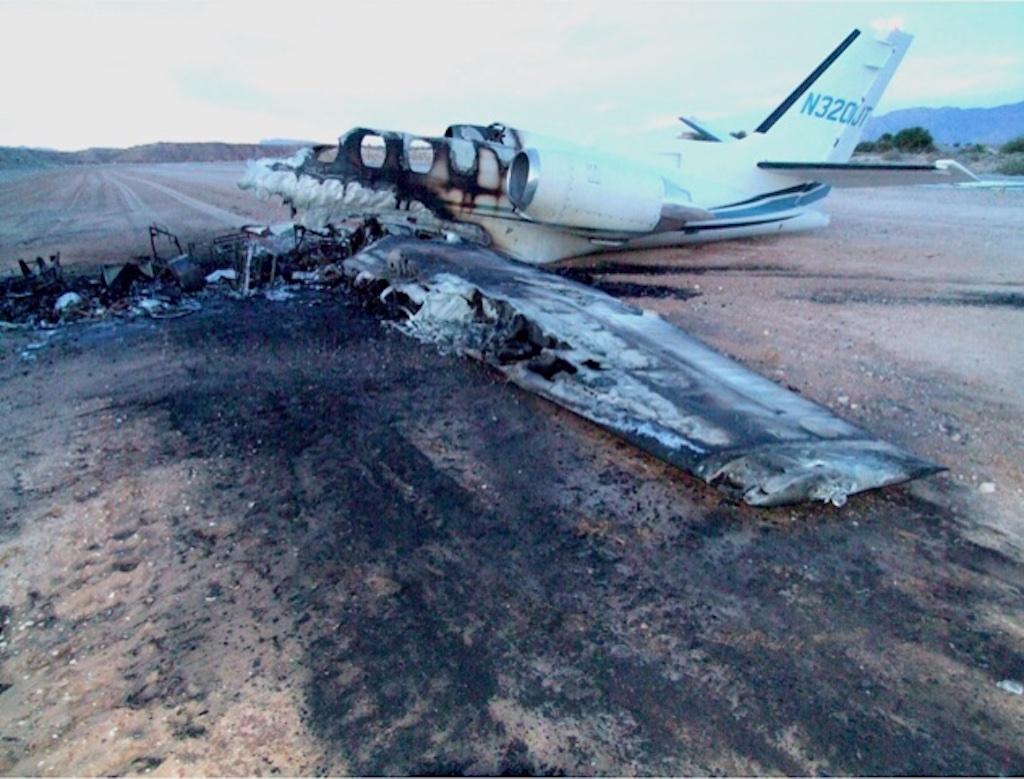
The wreckage of the Cessna 550 after crash landing at Mesquite Airport.
Mesquite Airport staff witnessed the crash landing of the Cessna 550 and responded to the accident site. When they questioned the pilot, he said he had been drinking and said, perhaps sorrowfully, that his bottle of vodka had burned in the fire. He refused to take a standard sobriety test and was arrested for operating an aircraft under the influence of a liquor.
Two hours after the accident, the Henderson Police Department drew blood from the pilot and found his blood alcohol count (BAC) was 0.288%. According to the Cleveland Clinic, a BAC between .15% and .30% produces confusion, vomiting and drowsiness. The pilot may have been over .30% when he landed. That level of intoxication is likely to cause alcohol poisoning, which is life-threatening and causes loss of consciousness.
By my count, the pilot made at least seven significant errors in his last hour of flight, in addition to his crash landing. The reason for the errors is self-evident, but they illustrate the extreme hazard of flying while intoxicated.
The pilot, who was 41 years old, reported total flight time of 17,000 hr., including 2,000 in the Citation, and he reported having type ratings in the Citation CE500, CE550 and 560, Beechcraft RA-390, King Air BE300 and Boeing 737. He had a current Class II medical certificate with a requirement to wear contact lenses. He held ATP certificates for airplanes and helicopters and was a flight instructor.
The limited investigation did not report any alcohol violations by the pilot. However, according to the Las Vegas Review-Journal, he had been convicted of driving under the influence (DUI) in Spokane in 2007. The National Driver Registry contains such information and could have been checked. Also not answered by the investigation was why a mid-career ATP pilot with 17,000 hr. was not professionally employed.
FAA Prohibition
Flying while intoxicated is, of course, prohibited by 14 CFR 91.17. In addition, the FAA application for an airman medical certificate requires the pilot to disclose “substance dependence” or having “failed a drug test ever” or any substance abuse “or use of an illegal substance in the last two years.” It separately requires disclosure of “alcohol dependence or abuse.” In addition, applicants must answer yes or no as to whether they have a history of arrests and/or convictions of driving while intoxicated or of any offense that resulted in a driving license suspension or attendance at a rehabilitation school. Details must be provided.
When the applicant signs the form, he or she attests the answers provided are complete and true. Whoever makes fraudulent statements may be fined up to $250,000 and imprisoned for up to five years, or both.
Since the pilot had a current medical certificate, he must have concealed his alcohol problems from the FAA. Unfortunately, such concealment is not unusual. I found 53 cases in the NTSB database where “intoxicated” was part of the factual narrative, and 32 cases where it was likely causal to the accident. All but one of the cases were conducted under Part 91.
One reason air carriers have very few “intoxication” related accidents is that commercial operators (Part 121 and 135) must comply with the 14 CFR 120, Drug and Alcohol Testing Program. Pilots, controllers, flight attendants, and anyone else in a safety-related position at an air carrier are subject to random drug and alcohol tests. The results of these tests become part of an individuals’ record, and a failed test generally results in termination and loss of certificate.
Many airlines have sponsored Human Intervention Motivational Study programs in cooperation with their pilot unions. These programs allow pilots to disclose their addictions, be grounded, and remain on the payroll while they are being treated. They must enter the program voluntarily, before they are caught by a test.
Generally, Part 91 operators don’t have such programs and don’t do such testing, but the Pilot Records Database (PRD) has imposed new reporting responsibilities. Regulation 14 CFR 111.1 (b) (4) requires reporting by Part 91 corporate operators if they fly at least two aircraft that either require a type rating or are turbine-powered helicopters. Fractional operators, air tour operators, public operators, Part 125 operators, and even bankrupt operators are also required to report information about their pilots.
Air carriers, 91K operators and air tour operators require driving records, including any DUI convictions, for their hiring processes.
The FAA is beginning enforcement of these rules on air carriers this year, and on other operators in 2024. Details can be found in FAA’s recent national policy, N8900.655, “Pilot Records Database Compliance Oversight,” issued on March 31, 2023.
The PRD is aimed at pilots with commercial or ATP certificates, not private pilots. Nonetheless, any pilot who flouts 91.17 or the medical reporting rules is risking severe punishment, not to mention his own injury or death.
The Peril Of Flying While Intoxicated, Part 1: https://aviationweek.com/business-aviation/safety-ops-regulation/peril-…






Comments